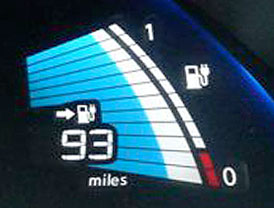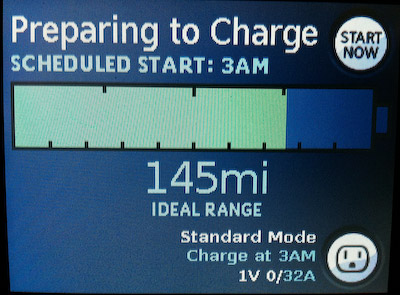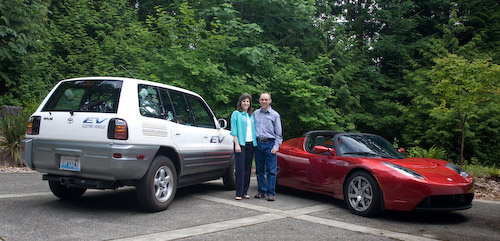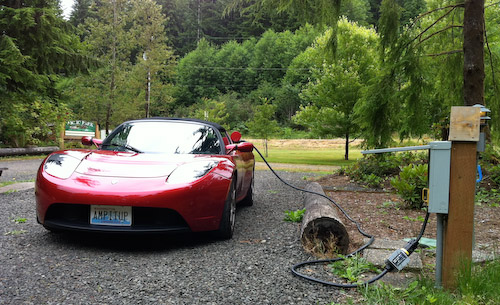Nissan has done a poor job of communicating state of charge to LEAF owners.

The first problem with this display is that you can't tell where you are with a simple glance. Quick: how many bars are there? Imagine if only some are lit up, how long does it take to count them? Once you have counted the bars, you have to divide by 12, or multiply by 8.3%. Like I want to do that while I'm driving! There's a nice number there, 93 miles, but the problem is that number varies wildly based on how you've been driving. Your state of charge might be 40% but the range estimate could be 12 miles if you just reached the top of 4,000-foot pass, or it might be 80 miles if you have been descending from that same pass. Likewise for just getting off of a stretch of 75 mph freeway versus getting onto the freeway after a stretch of 45 mph urban thoroughfare.
Drivers need to know what's in the battery unfiltered by a rating on their recent driving.
This isn't just my opinion, or the opinion of a few old school
EV fanatics. I keep hearing from new LEAF owners who after a few weeks of
driving realize that the estimated remaining miles on the LEAF dash is not useful. It's not that Nissan did it badly, or that it can be fixed by
improving their software, it's not what EV drivers need.
Ford is coming out with the Ford Focus Electric this year and is apparently asking for opinions on what drivers want to see on the dashboard.
First off, Ford should be asking what gas car drivers want to see and putting that in their ads, but they should be asking what experienced EV drivers want to see and put
that on the dash. Ford should start with dropping a line to the folks at
Plug In America.
When I'm driving, I don't want to see animations or flashy graphics in
my main field of view. I'm not watching a movie, I don't need special
effects, and I definitely don't need running commentary on my driving. The LAST thing I want to see on the dash is any mention of gasoline. Did
the Model T need a gauge showing how many bales of hay had been saved?
Please don't let some gas-driving marketing intern design the dash for an electric vehicle based on talking to other people who haven't owned an electric vehicle.
My wife and I have been driving electric for three years and have logged over 38,000 electric miles. We've done lots of local driving and enough road trips beyond our single charge range that we know what we need.
What I do want to see, in order of importance, is:
- Speed, preferably numerical, very easy to read at a glance, the biggest number on the screen.
- After speed, the single most important information an EV driver needs is the state of charge, SOC. This should be conveyed as remaining charge energy, in numerical resolution comparable to a mile's worth of driving, and not mangled by some unknown function of my recent driving and road conditions.
- Instantaneous energy use. This should be graphical and clearly show whether I'm using or generating energy and how much, even when it's a small amount. Having a number would be nice, but not necessary.
- Trip meter, preferably selectable from several. Having a trip meter that automatically resets after each full charge would be cool, but we still want user-controlled trip meters.
- Estimated miles remaining based on recent driving is rarely useful, but it would probably be weird to not have it available. Most people think that will be useful until they get used to driving electric. Not having it would be a distracting omission for new owners. It can be on the dash, even on by default, but there should be a way to get rid of it, perhaps making it an alternate to an absolute remaining energy number.
The purpose of showing the state of charge isn't really about figuring out how far you can drive with the current charge. The answer to that question depends on too many factors to ever be a meaningful single number on the dash. Instead, the EV driver needs to answer two simple questions:
1) Do I have enough energy to make it to my destination?
2) If the answer to #1 is "maybe", how do I need to moderate my driving to make it?
Most of the time the answer to #1 is an unconditional "yes". An answer of "no" means it's time to find charging, a condition that should be rare if the car is being used for local driving as intended. If the answer to #1 is "maybe", then I need the best information possible to answer #2.
Note that an
estimated range is always wrong when it matters because it assumes my driving style and road conditions are going to remain constant. It's basically telling me how I have been driving. I don't care about that. I need the information that will make it clear how I need to be driving for the rest of my trip.
For this reason, the choice of energy unit for the SOC display is critical. I want something more convenient than kWh, something that will not require doing math to interpret the number. If a vehicle has a certain stated nominal range, which corresponds to X Wh per mile (battery-to-wheel), then the ideal energy unit is X Wh. Tesla calls this an "ideal range mile." Call it whatever you like, but it's a very convenient unit of energy as it tells me how much is in the battery and gives me a range goal I can generally meet or even exceed if I need to.
If a car has a nominal range of 100 miles, then SOC percent corresponds to one mile of nominal driving. That's cool, but it doesn't generalize very well. When next year's model has a range of 140 miles, I don't want to have to multiply SOC percent by 1.4 to get nominal miles.
Showing SOC as kWh is even worse. Not only do I have to multiply by some goofy factor, it's a different factor for every car depending on weight and aerodynamics. Showing kWh used as part of a trip meter is awesome, and showing SOC in kWh has a certain appealing geek factor, but I don't want that to be my best-resolution SOC unit.
We'll all be better off if the car companies start showing SOC as nominal miles now.

On the Roadster, an "ideal range mile" is the amount of energy needed to drive one mile on the combined EPA driving cycle and corresponds to driving level highway at about 57 mph in moderate weather. Knowing this number and my miles to destination tells me how I need to drive to make it. This number slowly ticks down as I drive (occasionally ticking up on a long downhill drive), it doesn't fluctuate wildly as I go up and down shallow slopes and small hills. Nominal miles yields a much more reliable idea of remaining charge than an estimated-miles number can.
Having this number enables useful discussions about range and energy use among owners. If someone is planning a trip over the pass from Bellevue to Ellensburg, I can say that I've done that several times: traveling the ~100 miles over the 3,000-foot pass at 60 mph in moderate weather used 113 ideal miles and closer to the 70 mph speed limit used 119. It also makes planning for elevation possible. Every 1,000 feet of climbing uses up about 7 miles of nominal range, and going downhill gives about half of that back. Knowing that simple approximation makes it possible for a driver to plan a trip over a mountain pass just by knowing the required distance and elevation change. If other automakers use the appropriate nominal mile energy unit, these conversations will work across different makes and models, allowing drivers to share approximate energy expectations without a lot of goofy conversion math.
That probably sounds complicated. Just remember, electric vehicles are intended for local driving within their single-charge range. Most of the time the answer to the "do I have enough charge" is "yes, of course you do." It's only for the rare long trip that figuring things out is needed. Having good state of charge information available all the time will allow new drivers to develop experience and insight from their easy local driving that will make it possible for them to figure out which longer trips are practical. It's critical to widespread electric vehicle adoption that automakers get it right.







